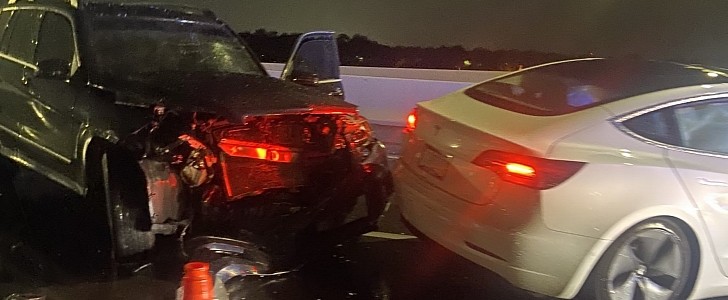NHTSA’s (National Highway Traffic Safety Administration) investigation on Tesla Autopilot hitting emergency vehicles reached a new chapter on September 13, 2021 - that was when the agency sent information requests to 12 other manufacturers. The idea is that it will help NHTSA check how these companies deal with their ADAS (advanced driver assistance systems) compared to Tesla.
To be more specific, the agency asked for information about “production vehicles equipped with the ability to control both steering and braking/accelerating simultaneously under some circumstances.” These requests have been sent to BMW, Ford, General Motors, Honda, Hyundai, Kia, Mercedes-Benz, Nissan, Stellantis, Subaru, Toyota, and Volkswagen.
Ford, GM, and Stellantis have to answer the information request until November 3. The other companies will have two more weeks for that, having to deliver the required documents by November 17.
Apart from data from the vehicles that present such systems, NHTSA also wants the companies to let the agency know about complaints, field reports, reports involving crashes with injury or deaths, property damage claims, arbitrations, and lawsuits related to ADAS.
The list is very long, and it shows the level of detail NHTSA needs to look at to assess how safely these companies are pursuing such systems. In other words, the accidents involving Autopilot brought scrutiny not only on what Tesla is doing, but to the industry as a whole. That may lead to more stringent rules for using ADAS, and even forbidding some of them to work on public roads.
On the other hand, the comparison can be really detrimental to Tesla. If these other automakers show that they are deploying such systems with a proper level of care – with few or no crashes with emergency vehicles or regular ones – Tesla’s 11 cases will make it look terrible compared to them.
As Mahmood Hikmet put it in a recent tweet, automakers have two choices regarding autonomous driving researches, and he knows what he is talking about. The AV researcher made a great video about Tesla’s approach to the technology that you must have watched already. In case you didn’t, click here to fix that.
The two choices Hikmet mentioned are to “proactively self-regulate” – keeping regulators at ease, sure that you are being cautious enough – or “force the hands” in these tests. In this last case, you give regulators no option but to impose stricter rules that can delay or even hamper the development of new technologies. As obvious as it seems, the investigation on Tesla shows the company picked the second choice. We may soon see the results for that method.
Ford, GM, and Stellantis have to answer the information request until November 3. The other companies will have two more weeks for that, having to deliver the required documents by November 17.
Apart from data from the vehicles that present such systems, NHTSA also wants the companies to let the agency know about complaints, field reports, reports involving crashes with injury or deaths, property damage claims, arbitrations, and lawsuits related to ADAS.
The list is very long, and it shows the level of detail NHTSA needs to look at to assess how safely these companies are pursuing such systems. In other words, the accidents involving Autopilot brought scrutiny not only on what Tesla is doing, but to the industry as a whole. That may lead to more stringent rules for using ADAS, and even forbidding some of them to work on public roads.
On the other hand, the comparison can be really detrimental to Tesla. If these other automakers show that they are deploying such systems with a proper level of care – with few or no crashes with emergency vehicles or regular ones – Tesla’s 11 cases will make it look terrible compared to them.
As Mahmood Hikmet put it in a recent tweet, automakers have two choices regarding autonomous driving researches, and he knows what he is talking about. The AV researcher made a great video about Tesla’s approach to the technology that you must have watched already. In case you didn’t, click here to fix that.
The two choices Hikmet mentioned are to “proactively self-regulate” – keeping regulators at ease, sure that you are being cautious enough – or “force the hands” in these tests. In this last case, you give regulators no option but to impose stricter rules that can delay or even hamper the development of new technologies. As obvious as it seems, the investigation on Tesla shows the company picked the second choice. We may soon see the results for that method.
Either you proactively self-regulate and over-deliver on safety so you can develop with minimal regulation.
— Mahmood Hikmet (@MoodyHikmet) September 14, 2021
Or you force the hands of regulators to codify safety and make R&D harder for the entire industry when your tech inevitably contributes to harming people.
Easy choice. https://t.co/S91SJAObH4


















